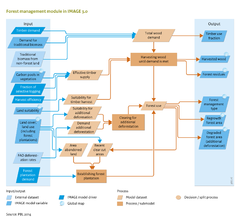Forest management/Description: Difference between revisions
Jump to navigation
Jump to search
No edit summary |
No edit summary |
||
| Line 1: | Line 1: | ||
{{ComponentDescriptionTemplate | {{ComponentDescriptionTemplate | ||
|Reference=Kallio et al., 2004; FAO, 2001a; FAO, 2008; Brown, 2000; Carle and Holmgren, 2008 | |Reference=Kallio et al., 2004; FAO, 2001a; FAO, 2008; Brown, 2000; Carle and Holmgren, 2008; FAO, 2012b; FAO, 2010; | ||
|Description=The forest management module describes regional timber demand and the production of timber in the three different management systems clear felling, selective felling and forest plantations. Deforestation rates reported by {{abbrTemplate|FAO}} are used to calibrate deforestation rates in IMAGE, using a so called additional deforestion. | |Description=The forest management module describes regional timber demand and the production of timber in the three different management systems clear felling, selective felling and forest plantations. Deforestation rates reported by {{abbrTemplate|FAO}} are used to calibrate deforestation rates in IMAGE, using a so called additional deforestion. | ||
| Line 15: | Line 15: | ||
===Forest plantations=== | ===Forest plantations=== | ||
Forest plantations are established for efficient, commercially viable wood production. Their regional establishment in IMAGE 3 is scenario driven (see also Input/Output Table at [[Forest management|Introduction part]]), based on FAO. The expectation is that increasingly more wood will be produced in plantations because sustainability criteria may limit harvest from natural forests ([[Brown, 2000]]; [[Carle and Holmgren, 2008]]; [[FAO, | Forest plantations are established for efficient, commercially viable wood production. Their regional establishment in IMAGE 3 is scenario driven (see also Input/Output Table at [[Forest management|Introduction part]]), based on FAO. The expectation is that increasingly more wood will be produced in plantations because sustainability criteria may limit harvest from natural forests ([[Brown, 2000]]; [[Carle and Holmgren, 2008]]; [[FAO, 2012b S]]). The development of forest plantations in IMAGE and [[LPJmL model|LPJmL]] is still under development, but expected to be available soon. Forest plantations are assumed to be established firstly on abandoned agricultural land. When sufficient abandoned land is not available, forest plantations are established on cleared forest areas. When a forest plantation has been established, the land cannot be used for other purposes or converted to natural vegetation until the tree rotation cycle has been completed. | ||
===Additional deforestation === | ===Additional deforestation === | ||
Revision as of 15:09, 21 May 2014
Parts of Forest management/Description
| Component is implemented in: |
| Components: |
| Related IMAGE components |
| Projects/Applications |
| Key publications |
| References |
